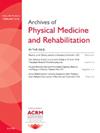Effect of Executive Function to Postural Control During Standing in People With Diabetes Mellitus—A Dual-task Study
IF 3.6
2区 医学
Q1 REHABILITATION
Archives of physical medicine and rehabilitation
Pub Date : 2025-04-01
DOI:10.1016/j.apmr.2025.01.028
引用次数: 0
Abstract
Objectives
To investigate the contribution of executive function to postural control in people with diabetes mellitus (DM) and age-matched healthy adults (HC) during a dual-task paradigm.
Design
A cross-sectional and observational study.
Setting
Hospital and research institute setting.
Participants
Ten patients diagnosed with DM (age, 58.9±10.3y; 4 women) and 10 HC (age, 62.1±11.9y; 7 women) were recruited. Key inclusion criteria for DM patients included: (1) the age ranges from 19 to 79 years; (2) can stand independently; and (3) no neuromuscular conditions, which influence the balance.
Interventions
To perform the virtual reality-based sensory organization test (SOT), participants were instructed to stand on the force plate with virtual reality goggles with a harness system. A foam pad was used for conditions with the uneven surface. An auditory Stroop test (AST) was administered concurrently in the dual-task condition.
Main Outcome Measures
To measure postural sway, root mean square values of rambling-trembling displacement decomposed from center of pressure were calculated through the MATLAB. The SOT scores were calculated to measure the postural sway contributed by individual sensory systems. The correctness of AST and the dual-task cost (DTC) of postural sway were calculated to assess the executive function. We hypothesized that the poorer executive function presented by lower correctness of AST and greater DTC can be observed in DM group as compared with HC group.
Results
When compared with HC group, the significantly lowered AST correctness was observed in the DM group. The significantly lowered DTC of SOT score regarding root mean square rambling in the anteroposterior direction was observed in the DM group when the vision dominates.
Conclusions
The lowered AST correctness in people with DM indicated the altered executive function through the dual-task paradigm. The postural control was not altered in the DM group as the lower DTC of SOT score was observed. In the dual-task paradigm, people with DM may apply greater cognitive resource involvement in postural control than in the secondary task.
Disclosures
none.
糖尿病患者站立时执行功能对姿势控制的影响——一项双任务研究
目的探讨双任务模式下糖尿病患者(DM)和年龄匹配的健康成人(HC)的执行功能对姿势控制的影响。设计一项横断面观察性研究。医院及科研院所设置。10例确诊为糖尿病的患者(年龄:58.9±10.3岁;女性4例),HC 10例(年龄:62.1±11.9y;7名女性)被招募。DM患者的主要入选标准包括:(1)年龄19 ~ 79岁;(2)能独立站立;(3)无影响平衡的神经肌肉疾病。干预措施:为了进行基于虚拟现实的感官组织测试(SOT),参与者被指示戴着带有安全带系统的虚拟现实护目镜站在测力板上。在表面不平整的情况下使用泡沫垫。在双任务条件下同时进行听觉Stroop测试(AST)。为了测量体位摇摆,通过MATLAB计算压力中心分解后的漫颤位移的均方根值。计算SOT分数是为了测量由个体感觉系统引起的姿势摇摆。计算AST的正确性和姿势摇摆的双任务代价(DTC)来评估执行功能。我们推测,与HC组相比,DM组AST的正确性较低,DTC较高,执行功能较差。结果与HC组比较,DM组AST的正确性明显降低。DM组视觉占主导地位时,前后方向均方根漫步的SOT评分DTC显著降低。结论DM患者AST正确率降低,提示双任务范式下执行功能的改变。DM组体位控制未发生改变,但SOT评分的DTC较低。在双任务范式中,糖尿病患者在姿势控制方面的认知资源投入比次要任务更多。
本文章由计算机程序翻译,如有差异,请以英文原文为准。
求助全文
约1分钟内获得全文
求助全文
来源期刊
CiteScore
6.20
自引率
4.70%
发文量
495
审稿时长
38 days
期刊介绍:
The Archives of Physical Medicine and Rehabilitation publishes original, peer-reviewed research and clinical reports on important trends and developments in physical medicine and rehabilitation and related fields. This international journal brings researchers and clinicians authoritative information on the therapeutic utilization of physical, behavioral and pharmaceutical agents in providing comprehensive care for individuals with chronic illness and disabilities.
Archives began publication in 1920, publishes monthly, and is the official journal of the American Congress of Rehabilitation Medicine. Its papers are cited more often than any other rehabilitation journal.

 求助内容:
求助内容: 应助结果提醒方式:
应助结果提醒方式:


